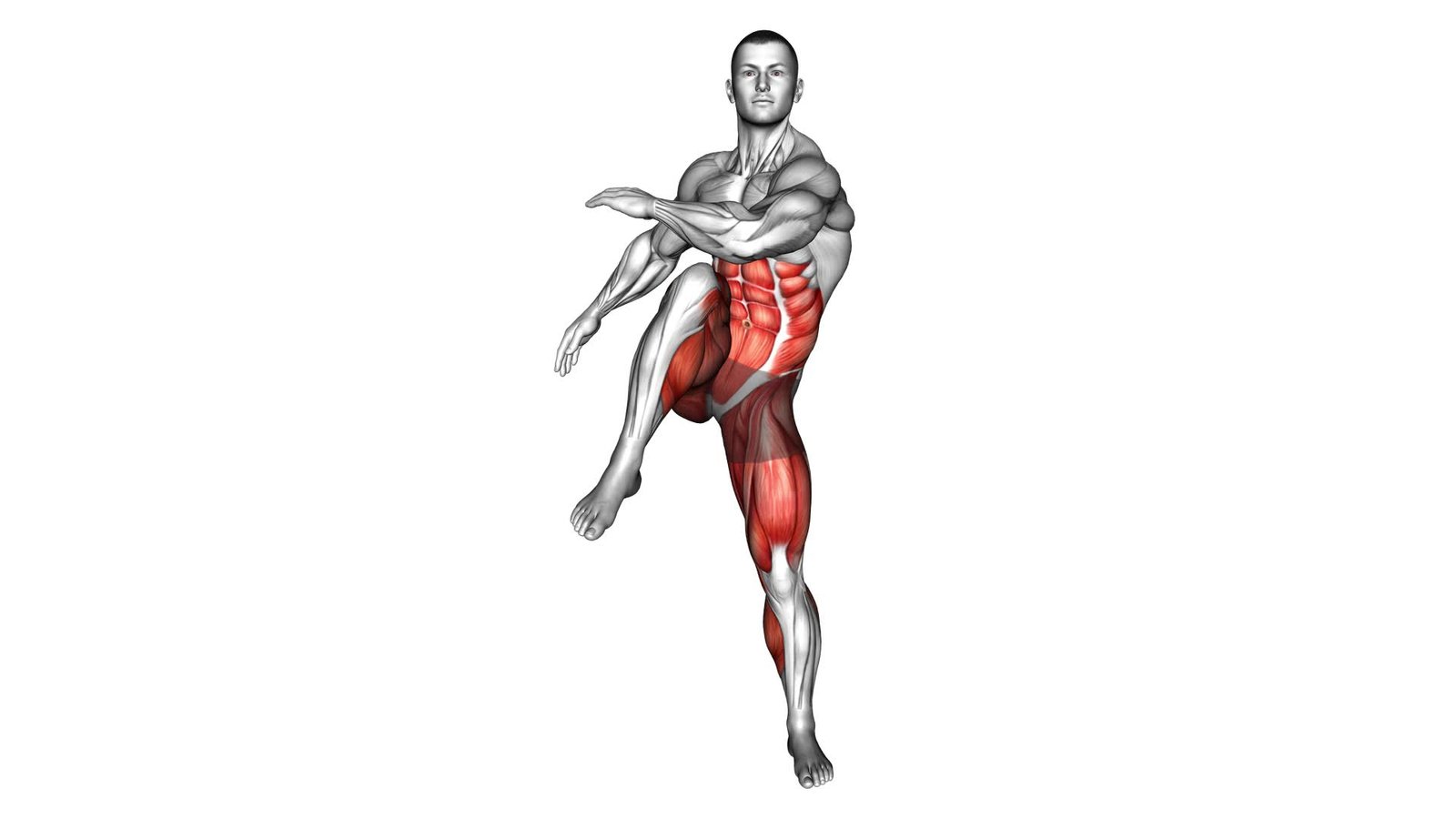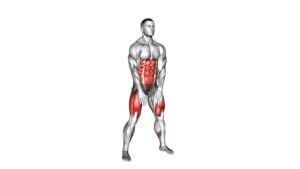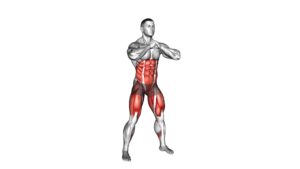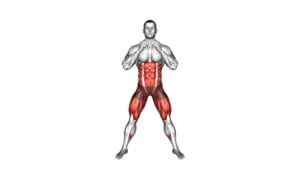Squat and Knee (male) – Video Exercise Guide & Tips

Get ready to strengthen your lower body with the Squat and Knee exercise!
Watch This Exercise Video
This video exercise guide & tips will show you the proper form and technique to maximize your results. Avoid common mistakes and learn variations and modifications to tailor the exercise to your fitness level.
Whether you're a beginner or advanced, incorporating the Squat and Knee exercise into your workout routine will help you build muscle and increase stability.
Let's get started!
Key Takeaways
- Squat and Knee exercise strengthens lower body muscles and improves overall stability.
- Proper form and technique include maintaining neutral spine, aligning knees with toes, and engaging core muscles.
- Common mistakes to avoid are letting knees cave inward, not going deep enough into the squat, and rounding the back.
- Variations and modifications for the exercise include pistol squat, sumo squat, jump squat, Bulgarian split squat, and goblet squat.
Benefits of the Squat and Knee Exercise
The squat and knee exercise offers numerous benefits for those looking to strengthen their lower body muscles and improve overall stability. By incorporating this exercise into your workout routine, you can effectively improve leg strength and prevent knee injuries.
Squats target multiple muscles in your lower body, including the quadriceps, hamstrings, and glutes. As you lower your body down into the squat position, these muscles are engaged, helping to build strength and endurance. Additionally, squats promote stability in the knees by strengthening the surrounding muscles and ligaments, reducing the risk of injuries. Stronger leg muscles also provide better support for the knees during other activities, such as running or jumping.
Proper form and technique are crucial for maximizing the benefits of the squat and knee exercise. By maintaining a neutral spine, keeping your knees aligned with your toes, and engaging your core, you can ensure proper alignment and reduce the risk of strain or injury.
Transitioning into the subsequent section about proper form and technique, let's dive deeper into the details of performing the squat and knee exercise correctly.
Proper Form and Technique for the Squat and Knee Exercise
To perform the squat and knee exercise correctly, focus on maintaining proper form and technique throughout the movement. Here are some key points to keep in mind:
- Benefits of proper form: Proper form ensures that you engage the correct muscles, maximizing the effectiveness of the exercise. It helps prevent injuries and promotes overall strength and stability.
- Importance of knee alignment: Proper knee alignment is crucial to protect your joints from unnecessary stress and strain. Keep your knees in line with your toes throughout the movement to avoid potential injuries.
To maintain proper form and technique during the squat and knee exercise, follow these guidelines:
- Stand with your feet shoulder-width apart and toes slightly turned out.
- Keep your chest lifted, shoulders down, and core engaged throughout the exercise.
- Lower your body by bending your knees, pushing your hips back, and keeping your weight in your heels.
- Aim to lower until your thighs are parallel to the ground, or as low as you can comfortably go.
- Push through your heels to return to the starting position, engaging your glutes and quadriceps.
Common Mistakes to Avoid During the Squat and Knee Exercise
Avoid these common mistakes when performing the squat and knee exercise to ensure proper form and maximize its effectiveness.
One of the most important aspects to focus on is proper alignment. Avoid letting your knees cave inward during the squat. This puts unnecessary stress on your knees and can lead to injuries. Instead, make sure your knees track in line with your toes throughout the movement.
Another common mistake isn't going deep enough into the squat. Going too shallow limits the benefits of the exercise and can put strain on your knees and lower back. Aim to lower your hips below parallel, while keeping your chest up and your core engaged.
It's also important to avoid rounding your back during the squat. This can lead to back pain and injury. Maintain a neutral spine throughout the movement by keeping your chest lifted and your shoulders back.
Lastly, avoid lifting too heavy of a weight before mastering the proper form. Start with a lighter weight and gradually increase as your strength and technique improve.
Variations and Modifications for the Squat and Knee Exercise
To add variety and challenge to your squat and knee exercise routine, try incorporating different variations and modifications. Here are some options to keep your workouts interesting and target different muscle groups:
- Pistol Squat: This variation involves performing a squat while balancing on one leg. It increases the demand on your core and leg muscles.
- Sumo Squat: Stand with your feet wider than shoulder-width apart and toes pointing outwards. This modification targets your inner thighs more than a traditional squat.
- Jump Squat: Add an explosive element to your routine by incorporating jump squats. This variation helps improve power and cardiovascular fitness.
- Bulgarian Split Squat: Elevate your back foot on a bench or step, and perform a squat with one leg in front. This modification challenges your balance and targets your glutes and quads.
- Goblet Squat: Hold a dumbbell or kettlebell close to your chest while performing a squat. This modification helps improve upper body strength and stability.
Tips for Incorporating the Squat and Knee Exercise Into Your Workout Routine
Looking to maximize the effectiveness of your squat and knee exercise routine? Here are some tips for incorporating squats and knee exercises into your workout routine.
Firstly, it's important to warm up properly before starting any exercise routine. This will help prepare your muscles and joints for the movements involved in squats and knee exercises. You can warm up by doing some light cardio exercises like jogging or jumping jacks, followed by dynamic stretches for your lower body.
When incorporating squats into your routine, start with bodyweight squats to master the proper form. Once you feel comfortable, you can progress to using dumbbells or a barbell for added resistance. Remember to keep your knees in line with your toes and maintain a neutral spine throughout the movement.
To target your knees specifically, you can include exercises like knee extensions or seated leg curls in your routine. These exercises help strengthen the muscles around your knees and improve stability.
It's also important to listen to your body and start with weights that are appropriate for your fitness level. Gradually increase the weight as you get stronger and more comfortable with the exercises.
Incorporating squats and knee exercises into your workout routine can help improve your lower body strength, stability, and overall fitness. Remember to always consult with a professional trainer or healthcare provider before starting any new exercise program.
Keep pushing yourself and stay consistent to see the best results.
Frequently Asked Questions
What Are the Different Muscles Targeted During the Squat and Knee Exercise?
During the squat and knee exercise, various muscles are targeted.
The squat primarily works your quadriceps, hamstrings, and glutes, while the knee exercise targets your quadriceps and calves.
Incorporating different variations of these exercises into your workout routine can provide numerous benefits, including increased leg strength, improved balance, and enhanced overall lower body stability.
How Many Sets and Reps Should I Do for the Squat and Knee Exercise?
To determine the number of sets and reps for the squat and knee exercise, consider your fitness level and goals.
As a beginner, start with 2-3 sets of 10-12 reps, focusing on proper form and technique. Gradually increase the intensity by adding more sets or reps.
To modify the exercise for beginners, use a chair or support for balance.
Common mistakes to avoid include leaning too far forward or letting your knees go past your toes.
Can the Squat and Knee Exercise Help Improve Knee Stability?
The squat and knee exercise can definitely help improve knee stability. By incorporating this exercise into your workout routine, you can strengthen the muscles around your knees, which can provide better support and stability.
Proper technique is crucial for maximizing the benefits of this exercise. Make sure to maintain proper form, keeping your knees aligned with your toes and avoiding any inward collapsing. Focus on engaging your core and using your glutes to power through the movement.
Is It Safe to Perform the Squat and Knee Exercise if I Have Knee Pain or a Knee Injury?
If you have knee pain or a knee injury, it may not be safe to perform the squat and knee exercise. It's important to listen to your body and avoid any exercises that cause pain or discomfort.
Instead, you can try alternative exercises for knee pain relief, such as leg extensions or seated leg presses.
Remember to consult with a healthcare professional before starting any new exercise routine, especially if you have an existing knee condition.
Can the Squat and Knee Exercise Help Improve Athletic Performance, Such as Vertical Jump Height or Running Speed?
To improve your athletic performance and prevent knee injuries, incorporating the squat and knee exercise into your routine can be beneficial.
This exercise targets the muscles in your legs, including your quadriceps, hamstrings, and glutes, which are essential for running speed and vertical jump height.
By strengthening these muscles, you can enhance your overall power and explosiveness, leading to better performance in sports and physical activities.
Remember to consult with a fitness professional if you have any concerns about your knee health.
Conclusion
In conclusion, the squat and knee exercise is a highly beneficial workout that targets the lower body muscles. By maintaining proper form and technique, you can maximize the benefits and avoid common mistakes.
There are also variations and modifications available to cater to different fitness levels. Incorporating this exercise into your workout routine can help strengthen your legs, improve balance, and enhance overall fitness.
Start incorporating the squat and knee exercise into your workouts for a stronger and healthier lower body.

Author
Years ago, the spark of my life’s passion ignited in my mind the moment I stepped into the local gym for the first time. The inaugural bead of perspiration, the initial endeavor, the very first surge of endorphins, and a sense of pride that washed over me post-workout marked the beginning of my deep-seated interest in strength sports, fitness, and sports nutrition. This very curiosity blossomed rapidly into a profound fascination, propelling me to earn a Master’s degree in Physical Education from the Academy of Physical Education in Krakow, followed by a Sports Manager diploma from the Jagiellonian University. My journey of growth led me to gain more specialized qualifications, such as being a certified personal trainer with a focus on sports dietetics, a lifeguard, and an instructor for wellness and corrective gymnastics. Theoretical knowledge paired seamlessly with practical experience, reinforcing my belief that the transformation of individuals under my guidance was also a reflection of my personal growth. This belief holds true even today. Each day, I strive to push the boundaries and explore new realms. These realms gently elevate me to greater heights. The unique combination of passion for my field and the continuous quest for growth fuels my drive to break new ground.



